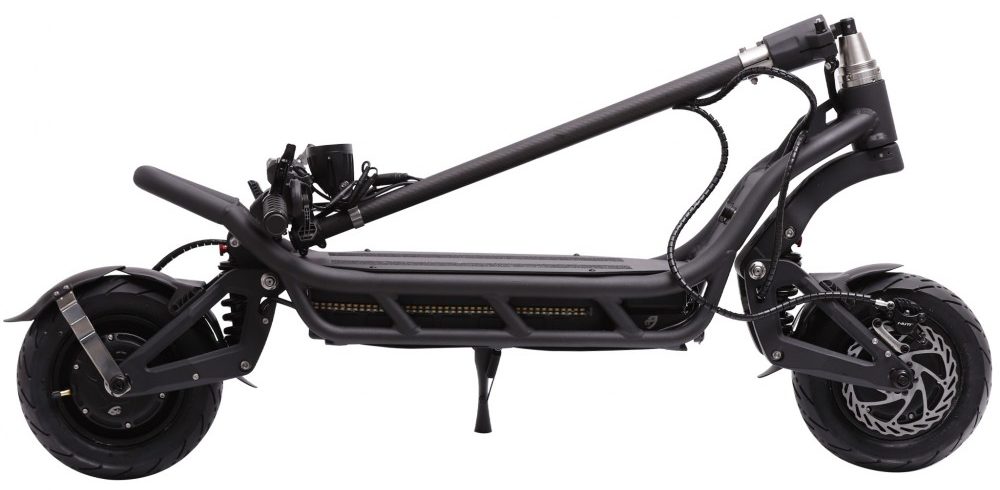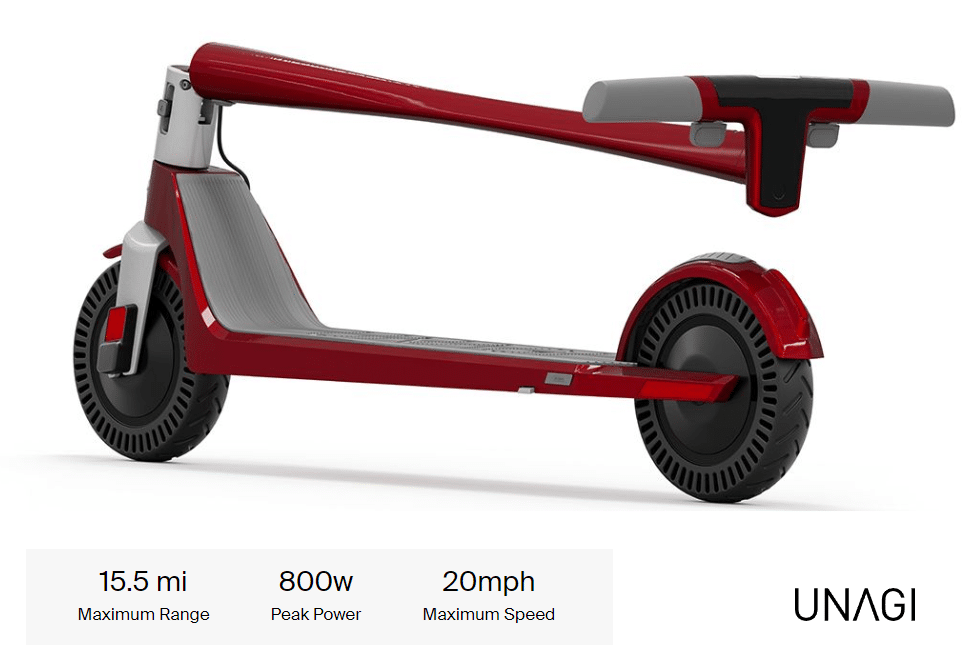Table of Contents
Did you know it is possible to optimise and refine this on-and-off-road beast by adjusting its suspension?
When Michael Sha, a rogue salesman who unceremoniously left Kaabo to start his scooter brand, announced his plans for Nami Burn E, it instantly became one of the most anticipated electric scooters in the world. Burn E was initially branded “Viper” due to its superior performance and tabular frame, reminiscent of a snake that’s ready to strike.
The vehicle, which is considered by many in the electric scooter world as one of the most complete high-performance electric scooters, brings a plethora of cutting-edge features and functions that help it deliver blazing speeds and an extensive range. Equipped with front and rear 1500W motors, the Nami Burn E delivers a blistering top speed of 60 mph and tackles hills with up to 35-degree inclines.
Its two motors are powered by a massive 72V 35Ah battery, with enough juice for up to 100 miles. With two powerful 1500W motors that deliver 8400W peak power, a turbo mode and a pair of Sine Wave 50Ah controllers, you’ll never have to struggle with acceleration when riding the Nami Burn E electric scooter.
This high-performance e-scooter weighs 103 pounds, with the bulk of this weight coming from its sturdy and solid tubular frame and stem, made from aviation-grade aluminium and carbon fibre. All its moving parts and metal accessories are made of polished stainless steel.
The Nami Burn E Viper can support up to 330 pounds. Although its weight makes it unsuitable to carry around, the scooter boasts a patented lock-taper folding mechanism that allows it to collapse for relatively compact transportation. Its 11-inch air-filled tyres combine with adjustable 165 mm hydraulic coil-shock suspensions on both wheels to deliver a superb ride quality. It also comes with 186 rear NUTT hydraulic brakes that boast 160 mm discs and an integrated electric brake for reliable and confident braking.
The Nami Burn E e-scooter comes with an all-round lighting system that comprises the 2K-Lumen headlight, brake-activated taillight, and side LED strips integrated with the turn signal. The lights help riders see everything clearly on the road after dark, stay visible to other motorists, and create a fascinating light show that will turn heads as they cascade through the city.
Another classic feature of the Nami Burn E Viper is its dual IP ratings. Its display is rated with IP56 for water resistance, while the rest of the scooter, including the electric components, comes with an IP55 water-resistance rating. This e-scooter also touts an industry-leading interface that allows riders to customise any imaginable data point. Finally, its loud motorcycle horn helps riders warn pedestrians and other motorists on the road.

Adjusting the Nami Burn E Electric Scooter’s Suspension
One key feature that makes the Nami Burn E a top-performing electric scooter is its dual-adjustable 165 mm hydraulic-coil suspension. This is among the industry’s most respected suspension systems, renowned for delivering excellent levels of shock absorption.
Thanks to this system, the Nami Burn E can tackle all kinds of terrains, from mountains to grassland and deserts or even rainforests. Although the KKE hydraulic-coil over-shocks were initially designed for motorcycles, they have lately been utilised in many other motorised machines, including scooters. The integration of this type of suspension into the Nami Burn E offers insane levels of control, stability and comfort on any terrain.
More importantly, the e-scooter’s suspension boasts adjustable hydraulic damping. This means that you can configure the suspension to improve traction, speed and comfort. And while this shock system may look a little complex to the average rider, it is easy for riders to dial the amount of damping they want.
Out of the box, the Nami Burn E e-scooter’s suspension is fine-tuned to a certain degree, but riders complain of some wobbles when they press the throttle and release it while slowing down. However, riders can easily adjust the shock’s rebound setting to eradicate the off-throttle wobbles.
How to Adjust the Nami Burn E Hydraulic Coil-Shock Suspension
Before we jump straight into the adjustment process, let’s first look at the main components of a standard hydraulic coil-shock suspension system:
Preload
This part raises the suspension and ensures that it stays at the top.
Coil/Spring
The spring is the part that travels up and down when riders hit a bump. It carries their weight, sets the scooter’s height, and lowers the impact when they hit a pothole.
Shocks
The shocks keep the spring in place and ensure that the wheels rest comfortably on the ground.
Limiter Straps
Straps help limit the impact that reaches the shocks.
What Suspension Elements Should You Adjust?
Adjusting the suspension is not a one-size-fits-all process. Different riders adjust the shocks according to their preferences and needs. However, the process involves tuning various adjustable settings until they achieve the desired results.
Below are the most-adjusted standard settings for the Nami Burn E electric scooter.
Adjusting the Sag
Sag measures the extent to which a suspension squats when an electric scooter is at rest. Essentially, sag can be measured when the scooter is idle or on the rider.
The extent to which a suspension squats when an electric scooter is sitting still is known as “static/free sag.” On the other hand, the measure of the squat when the rider is on the scooter is known as “active/ race/rider sag.”
It’s recommended that riders make the sag the starting point of any suspension setup. Before making any hydraulic adjustments, they first need to set the rider sag. Essentially, the rider sag should be 1/3 of the stroke. So, if the stroke is 180 mm, then the rider sag should be 60 mm.
To measure the sag, lift the scooter off the ground and let it rest on a stand with the under-deck where the shock absorbers have fully topped out. Measure the distance between the wheel axle and the top part of the rear fender, then note it down.
Put the e-scooter down and bounce it a few times. When the scooter is still, measure the distance between the axle and the top part of the fender, then note it down. The difference between the on-stand measurement and the second measurement is the static/free sag.
Next, get someone else to help calculate the rider sag. Riders should get into the riding position with their hands on the handlebars and their feet on the deck.
Get a friend to balance the scooter to stand upright and don’t lean to one side. Ask them to measure the distance between the wheel axle and the top part of the fender. Subtract this measurement from the measurement when the scooter was on the stand to get the active/race/rider sag.
If you discover your rider sag is on the 1/3 mark, or it matches the recommendation in the user manual, then you’re good to go. If it’s below or above the recommended value, then you’ll need to adjust the preload until you get the correct sag.
Adjusting the Preload
A preload adjuster is the O-ring that prevents the spring from moving out of position. To attain the correct sag, riders will need to fine-tune this function. Winding the preload adjuster inward will compress the spring, increase the preload, and reduce the rider sag. Conversely, winding it outward will relax the spring, decrease the preload, and increase the active sag.
Although the Nami Burn E electric scooter’s suspension feels amazing when riding it for the first time, it can develop some unsettling wobbles at high speeds, thereby cutting the throttle. If riders experience this problem, then they can try this standard setup technique used for motorcycles to make the steering angle less steep.
Dial in two full turns of the front preload adjuster and wind out the rear preload adjuster once. This will improve the steering angle and reduce the wobbles. Once the sag and preload are complete, riders can now turn their attention to the scooter’s damping.

Rebound Damping and Compression Damping
One impressive thing about the Nami Burn E electric scooter is that it comes with an easily adjustable suspension. Unlike other electric scooters, for which you would need various tools, you won’t need any wrench or C spanner to dial in the amount of damping you want. Everything is explicitly laid out to help new riders understand rebound and compression damping.
When it comes to suspension damping, two symbiotic facets come into play: compression damping and rebound damping. These two elements are mutually dependent, and riders can’t have one without another.
Compression damping is the ability to absorb and dissipate shock when your scooter hits bumps or potholes. On the other hand, rebound damping regulates the speed at which the shock absorbers bounce back to normalcy after compression.
Adjusting Compression
Compression damping determines how the shocks compress as riders hit potholes and bumps. When there is low compression damping, the shock absorbers feel soft and spongy. On the other hand, high compression makes the shock absorbers feel sharp and stiff. Riders will need to balance the two if they want the best results.
Look for the compression dial on the upper part of the shock body for the rear wheel and the lower part of the shock body for the front wheel. Usually, the compression knob/dial comes with distinctive markings to help riders know which way to turn them.
Turning the knob/dial clockwise will stiffen or tighten the compression, while the anti-clockwise direction will make the compression smoother and softer. Often, the decision to go for high compression or low compression will depend on the size and number of obstacles on the terrain.
When riders add compression, they firm up the suspension, allowing it to stay higher from the ground. This offers them more support when dealing with challenging obstacles or braking over bumps.
Adjusting the Rebound
The rebound determines the speed at which the shocks return to their original position after being compressed when riders hit an obstacle. The rebound is essential for traction and control. Its primary role is to ensure that the Nami Burn E e-scooter wheels stay on the ground—regardless of the impact.
If riders set the rebound too fast, it can make the e-scooter bounce off potholes and rocks. This can send the rider flying off the deck and make them lose control. On the other hand, setting the suspension too slow means that the shocks will take too long to regain full travel before the subsequent impact, making the e-scooter feel stiff.
While more sophisticated electric scooters may feature high-and-low-speed rebound settings, it’s unfortunate that the Nami Burn E e-scooter only has a low-speed rebound setting. This means that riders can only fine-tune the low-speed rebound adjuster since the high-speed function is factory set.
Nevertheless, riders can customise the scooter’s rebound to ensure that they don’t bounce off rocks or other rigid objects or feel like their suspension is bogged down as they ride on off-road terrains.

Should You Adjust Suspension on Your Viper Electric Scooter?
Although the manufacturer provides a detailed guide on adjusting the compression and rebound on the Nami Burn E electric scooter, riders should fine-tune these settings based on their unique riding circumstances. It’s recommended to toggle between compression and rebound simultaneously while taking test rides until they achieve the desired results.
While the Nami Burn E e-scooter is set to deliver smooth and comfortable rides on urban terrains, the flexible suspension configurations allow riders to fine-tune it to conquer less-reliable terrains as well. It’s advisable to start with slower settings and gradually tune the suspension damping to a higher edge so that riders can note the difference as they take the scooter for each test ride.
Conclusion
There’s no doubt that the Nami Burn E e-scooter is one of the best ultra-performance electric scooters on the market right now. But did you know it is possible to optimise and refine this on-and-off-road beast by adjusting its suspension?
This article is the only step-by-step guide you need to adjust the Nami Burn E e-scooter’s various suspension settings, from the sag and the preload to the compression and the rebound. These modifications can be invaluable for riders who want to get the best out of their Nami Burn.

Nely Hayes
BIO:
Nely is an adrenaline junkie and one of her life goals is to sky dive, but until that day she gets her kicks from testing fast electric scooters. Part time scooter fanatic & part time SEO analyst. Nely’s favourite scooter is the Dualtron X.

 Free Shipping
Free Shipping Service included
Service included Theft Insurance included
Theft Insurance included No BS
No BS